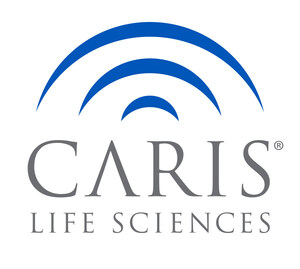Caris Molecular Intelligence Facilitates Comparison of Biomarker Profiles to Inform Targeted Treatment Strategies in Distinct Gynecological Cancers
Study Results Highlight Molecular Similarities and Differences between Uterine Papillary and Ovarian Serous Carcinomas, and between Epithelial Ovarian and Endometrial Cancers
IRVING, Texas, March 29, 2015 /PRNewswire/ -- Caris Life Sciences® today announced the presentation of two studies in which Caris Molecular Intelligence®, the company's panomic, comprehensive tumor profiling service, found that molecular similarities and differences between several rare and difficult to treat gynecological cancers may inform targeted treatment strategies that have the potential to improve patient outcomes. These studies were presented today during Poster Session B at the Society of Gynecologic Oncology (SGO) 2015 Annual Meeting on Women's Cancer in Chicago, Ill.
In each of these studies, conducted in collaboration with researchers from the Cleveland Clinic, Caris Molecular Intelligence® was used to compare uterine papillary serous carcinoma and ovarian serous carcinoma, and epithelial ovarian cancer and endometrial cancer, respectively. Caris Molecular Intelligence's multi-platform profiling approach includes gene sequencing (next-generation sequencing [NGS] and Sanger), protein expression analysis (immunohistochemistry [IHC]), and gene copy number analysis (chromogenic or fluorescence in situ hybridization [CISH or FISH]). Investigators used these methods to examine tumor samples for underlying molecular alterations that may yield insights into potentially overlapping and different therapeutic options for patients with these tumor types.
"In each of these studies, Caris Molecular Intelligence enabled researchers to examine the molecular diversity, and in some cases similarities, of each of these cancers providing information needed to better understand variations in molecular pathways for optimizing treatment selection," said Sandeep K. Reddy, M.D., Chief Medical Officer at Caris Life Sciences, and a co-investigator in each of the two studies. "We hope to further clarify the differences and similarities observed in future studies, and to use the accumulated evidence to inform evolving treatment paradigms in gynecologic cancer."
Uterine Papillary Serous Carcinoma versus Ovarian Serous Carcinoma
Researchers used Caris Molecular Intelligence® to evaluate 240 uterine papillary serous carcinoma (UPSC) and 1,587 epithelial ovarian serous carcinoma (EOC-S) samples, and to compare the molecular profiles of the two cancer subtypes.
The tumor suppressor gene TP53 was the most commonly mutated gene in both UPSC and EOC-S (76% vs. 69%) samples. UPSCs were more likely than EOC-S samples to harbor mutations in the oncogenes PIK3CA (29% vs. 2%), FBXW7 (12% vs. 1%), KRAS (9% vs. 5%), the tumor suppressor protein PTEN (7% vs. 1%), and CTNNB1 (2% vs. 0%).
"Whereas uterine papillary serous carcinoma appears to have a distinct mutation profile, indicating higher activity of the PI3K/PTEN/mTOR pathway, we saw no differences between uterine papillary and ovarian serous carcinomas in alteration of the homologous recombination pathway," remarked principal investigator Robert Debernardo, MD, Gynecologic Oncologist and Director of Minimally Invasive Surgery at the Cleveland Clinic Ob/Gyn & Women's Health Institute. "Also noteworthy was the overexpression of topoisomerase 2A and other markers, although these findings need to be correlated with outcome and response to chemotherapy."
There were no differences between UPSC and EOS-C in the rates of mutation of APC, ATM, BRAF, and AKT1. IHC analysis showed overexpression of the multidrug resistance protein 1 (MRP-1, 88% vs. 83%), the programmed cell death protein 1 (PD-1, 68% vs. 68%), PTEN (56% vs. 58%), topoisomerase 1 (TOPO1, 36% vs. 40%), and progesterone receptor (PR, 32% vs. 30%) in both UPSC and EOC-S samples. Methylguanine-DNA methyltransferase (MGMT) was more frequently expressed in EOC-S than in UPSC (80% vs. 53%). Conversely, IHC analysis showed that UPSC samples had higher expression of topoisomerase 2A (TOPO2A, 89% vs. 69%), estrogen receptor (ER, 60% vs. 53%), and ribonucleotide reductase M1 (RRM1, 35% vs. 27%) than did EOC-S samples. Similarly, CISH/FISH analysis indicated higher expression of HER2 (17% vs. 4%) and HER2/neu (10% vs. 2%) in UPSC than in EOC-S, respectively.
Epithelial Ovarian Cancer versus Endometrial Cancer
Using Caris Molecular Intelligence, Dr. Haider Mahdi and colleagues also evaluated 9,193 epithelial ovarian cancer (EOC) and 3,133 endometrial cancer (EC) specimens as a means to identify potential treatment strategies for each malignancy. TP53, which has been implicated as a driver mutation in both cancer types, was the most mutated gene in EOC (61%) and EC (43%) samples. Compared to the TP53-mutated tumors, TP53 wild type tumors carried significantly higher mutation rates in PTEN, PIK3CA, KRAS, and CTNNB1, indicating higher activation of the PI3K, MAPK, and Wnt pathways in TP53 wild type cohorts in both cancer types.
Notably, in EC samples, TP53 wild type cases showed significantly higher expression of ER (73% vs. 49%), PR (61% vs. 29%), and PD-L1 (33% vs. 14%), while TP53-mutated tumors showed significantly higher HER2 amplification (10% vs. 1%) and expression (7% vs. 1%); these associations were absent in the EOC samples. In contrast, in EOC samples, TP53 wild type tumors carried three times the cMET expression (29% vs. 9%), while BRCA1 and 2 mutations were significantly higher in TP53-mutated cases (39% vs. 23%), but this difference was not seen in EC tumors.
"Our results reveal the genetic heterogeneity of gynecological cancers and suggest an increased benefit of targeting the PI3K, MAPK, and Wnt pathways in TP53 wild type tumors in both epithelial ovarian cancer and endometrial cancer," said Dr. DeBernardo. "While hormonal and immunomodulatory therapies may be of particular interest for patients with TP53 wild type endometrial cancer, Her2-targeted therapies may benefit patients with TP53-mutated endometrial cancer. For women with epithelial ovarian cancer, cMET-targeted therapies and PARP inhibitors may be of particular interest for treating TP53 wild type and TP53-mutated tumors, respectively."
About Caris Life Sciences® and Caris Molecular Intelligence®
Caris Life Sciences® is a leading biotechnology company focused on fulfilling the promise of precision medicine through quality and innovation. Caris Molecular Intelligence®, one of the industry's leading tumor profiling services with more than 70,000 patients profiled, provides oncologists with the most potentially clinically actionable treatment options available to personalize cancer care today. Using a variety of advanced profiling technologies to assess relevant biological changes in each patient's tumor, Caris Molecular Intelligence connects biomarker data generated from a tumor with biomarker-drug associations supported by evidence in the relevant clinical literature. The company is also developing Carisome® TOP™ technology, a revolutionary and proprietary blood-based profiling platform for diagnosis, prognosis, and theranosis of cancer and other complex diseases. Headquartered in Irving, Texas, Caris Life Sciences offers services throughout Europe, the U.S., Australia and other international markets. To learn more, please visit www.CarisLifeSciences.com.
SOURCE Caris Life Sciences
Related Links
http://www.carislifesciences.com
WANT YOUR COMPANY'S NEWS FEATURED ON PRNEWSWIRE.COM?
Newsrooms &
Influencers
Digital Media
Outlets
Journalists
Opted In






Share this article